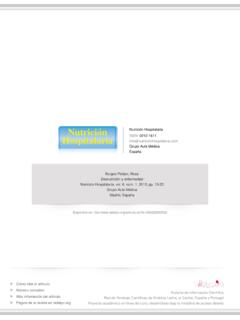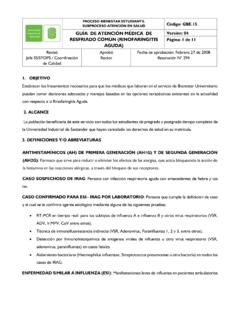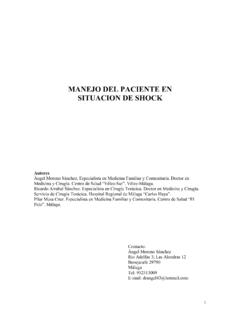Transcription of Aeromonas - World Health Organization
1 Aeromonas1 DescriptionSpecies of Aeromonasare Gram-negative, non-spore-forming, rod-shaped, facul-tatively anaerobic bacteria that occur ubiquitously and autochthonously inaquatic environments. Although historically the Aeromonas genus has been placedin the family Vibrionaceae (Popoff, 1984), there have been proposals to place itin its own family, the Aeromonadaceae (Colwell, MacDonnell & De Ley, 1986).The aeromonads share many biochemical characteristics with members of theEnterobacteriaceae, from which they are primarily differentiated by beingoxidase-positive. The genus includes at least 13 genospecies, among which arethe mesophilic A. hydrophila, A. caviae, A. sobria, A. veronii, and A. schubertii,and the non-motile, psychrophilic A. salmonicidais a fish pathogen and has not been associated with humaninfection.
2 By contrast, the mesophilic species have been associated with a widerange of infections in humans (Janda & Abbott, 1996). Although members ofthe genus have classically been divided into three biochemically differentiatedgroups (typified by A. hydrophila, A. caviae, and A. sobria), these contain anumber of genospecies, to which new species have been added (Carnahan &Altwegg, 1996). Currently the genus is made up of 17 DNA hybridization groupsrepresenting a range of genospecies and phenospecies (see Table 1).The mesophilic aeromonads have been commonly isolated from patientswith gastroenteritis although their role in disease causation remains unclear. Theyare also associated with sepsis and wounds, and with eye, respiratory tract, andother systemic infections (Janda & Duffey, 1988; Janda & Abbott, 1996; Nicholset al.)
3 , 1996); see Table 2. Many of the systemic infections arise following contamination of lacerations and fractures with Aeromonas -rich species principally associated with gastroenteritis are A. caviae, , and A. veroniibiovar sobria (Joseph, 1996); A. caviaeis particularlyassociated with young children (under 3 years of age). Many studies have resulted11 This review was prepared by Sartory, Quality and Environmental Services, Severn TrentWater, England, with contributions from L. Bonnadonna, Istituto Superiore di Sanit , Rome,Italy; Delattre, Institut Pasteur de Lille, Lille, France; P. Gosling, Department of Health ,London, England; M. Janda, Department of Health Services, Health and Welfare Agency, Berke-ley, CA, USA; and D. van der Kooij, Kiwa, Groningenhaven, FOR DRINKING-WATER QUALITY2 Table 1.
4 Genospecies and phenospecies of the genus AeromonasaDNAR eference strainGenospeciesPhenospecieshybridizati on(T =type strain)group1 ATCC 7966TA. hydrophilaA. hydrophila2 ATCC 51108TA. bestiarumA. hydrophila3 ATCC 33658TA. salmonicidaA. salmonicida3 CDC 0434-84A. salmonicidaA. hydrophila4 ATCC 15468TA. caviaeA. caviae5 ACDC 0862-83A. mediaA. caviae5 BCDC 0435-84A. mediaA. media6 ATCC 23309TA. eucrenophilaA. eucrenophila7 CIP 7433TA. sobriaA. sobria8 ATCC 9071A. veroniiA. veroniibiovar sobria9 ATCC 49568TA. jandaeiA. jandaei10 ATCC 35624TA. veroniiA. veronii11 ATCC 35941 UnnamedAeromonassp. (ornithine-positive12 ATCC 43700TA. schubertiiA. schubertii13 ATCC 43946 UnnamedAeromonasGroup 50114 ATCC 49657TA. trotaA. trota15 CECT 4199TA. allosaccharophilabA. allosaccharophilab16 CECT 4342TA. encheleiabA.)
5 EncheleiabaModified from Carnahan & Altwegg, taxonomic status of A. allosaccharophilaand A. encheleiaremains to be confirmed. A further newspecies, A. popoffi(unassigned DNA hybridization group), has also been the isolation of several species of Aeromonasfrom patients with gastroenteri-tis, and these have been extensively reviewed (Altwegg & Geiss, 1989; Janda,1991; Joseph, 1996). There has been considerable debate as to whether themesophilic aeromonads are primary enteropathogens, prompted largely by failureto establish significant infection in volunteer studies. In a study in which 57people were challenged using five strains of A. hydrophilawith doses ranging from 104to 1010organisms, only two individuals developed diarrhoea one hadmild diarrhoea after a dose of 109organisms and the other developed moderatediarrhoea after a dose of 107(Morgan et al.)
6 , 1985). The value of these data islimited, as the strains used were poorly characterized and some were not demon-strably enterotoxigenic (Gosling, 1996). However, there have been reports of laboratory-acquired infections in microbiologists who (unintentionally) ingestedsignificant doses of Aeromonasand developed self-limiting diarrhoea (Joseph,1996).Understanding the clinical significance of enteric isolates of Aeromonashasbeen further complicated by the fact that some studies have demonstrated similarisolation frequencies from symptomatic and asymptomatic adults (Altwegg &Geiss, 1989), while others have shown significant correlations between diarrhoeaand enterotoxin-producing Aeromonasspp. (Gracey, Burke & Robinson, 1982;Bloom & Bottone, 1990; Joseph, 1996).
7 Seasonal variations in isolation ofAeromonasfrom stools has also been reported, with highest recovery during thewarmer months (Burke et al., 1984a; Moyer, 1987). The available evidence indicates that people are generally unaffected by enteric Aeromonasand thataeromonads may be a natural part of the gut flora, either transiently or in the longerterm. A numbers of factors, including age, immunocompetence, infection dose,underlying illness, and expression of sufficient virulence factors by the infectingorganism, affect the ability of Aeromonasspp. to cause disease (Nichols et al., 1996).Although the pathogenesis of Aeromonasinfections remains poorly under-stood, mesophilic Aeromonasspp. can express a range of virulence factors(Gosling, 1996), including attachment mechanisms and production of a numberof toxins.
8 Several studies have demonstrated that strains of A. hydrophilaproducelectins and adhesins which enable adherence to epithelial surfaces and gut mucosa(Gosling, 1996). Additionally, two types of pili have been characterized fromHep-2-adherent A. hydrophila(Carrello et al., 1988; Gosling, 1996), and inva-sion of Hep-2 cells by faecally derived A. hydrophilahas also been reported(Lawson, Burke & Chang, 1985).Species of Aeromonasare capable of expressing a number of extracellulartoxins and enzymes (Gosling, 1996; Howard, MacIntyre & Buckley, 1996). Earlycharacterization of the toxins, however, resulted in confusion regarding theirAEROMONAS3 Table 2. Relative frequency of occurrence of human infectionsassociated with mesophilic AeromonasaType of infectionCharacteristicsRelative frequencybDiarrhoeaSecretoryAcute watery diarrhoea, vomitingVery commonDysentericAcute diarrhoea with blood and mucusCommonChronicDiarrhoea lasting more than 10 daysCommonCholeraic Rice water stoolsRareSystemicCellulitisInflammation of connective tissueCommonMyonecrosisHaemorrhage, necrosis with/withoutRaregas gangreneErythema Skin lesions with necrotic centre, sepsisUncommongangrenosumSepticaemiaFeve r, chills, hypotension, high mortalityFairly commonPeritonitisInflammation of peritoneumUncommonPneumoniaPneumonia with septicaemia.
9 Sometimes RarenecrosisOsteomyelitisBone infection following soft-tissue infectionRareCholecystitisAcute infection of gallbladderRareEye infectionsConjunctivitis, corneal ulcer, endophthalmitisRareaModified from Janda & Duffey, 1988, and Nichols et al., of occurrence relative to all cases of and activities. The primary toxins produced are haemolysins, of whichthe most significant is aerolysin, expressed by many strains of A. hydrophilaand A. sobria(Janda, 1991; Howard, MacIntyre & Buckley, 1996). This is a heat-labile b-haemolysin, which exhibits phospholipase A and C activity. It is a pore-forming cytolysin able to insert into the cell membrane bilayer causing leakage of cytoplasmic contents. Haemolytic enterotoxins have beenreported by some authors (Chopra, Houston & Kurosky, 1991; Gosling, 1996).
10 A weak haemolysin, glycerophospholipid:cholesterol acyltransferase (GCAT), has been characterized from A. hydrophilaand A. salmonicida(Howard, MacIn-tyre & Buckley, 1996); other haemolysins may also exist, but need to be isolatedand purified before haemolytic activity can be confirmed. In addition, at leastone cytotonic enterotoxin with similar activity to cholera toxin has been demon-strated (Ljungh, Eneroth & Wadstr m, 1982; Gosling et al., 1992; Gosling,1996), and there may be several. Evidence for plasmid-encoded expression by A. hydrophilaand A. caviaeof a cytotoxin similar to Shiga-like toxin 1 has beenreported (Haque et al., 1996). Species of Aeromonasalso produce a range of cell-surface and secreted proteases which probably enhance virulence (Gosling,1996).














